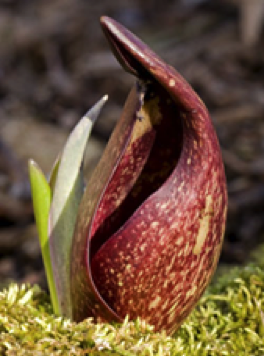February Phenom
February Phenom was originally published in the BFEC Newsletter, Vol. 15/No. 1, Winter 2011.
 Though it sounds unappealing, skunk cabbage is a fascinating plant. For some it is a cause for joy, being the very first plant of the year to bloom, quite miraculously, in late February. Looking very little like a typical flower, it emerges from forested wetlands cloaked by a wine-colored, pointed hood (called a “spathe”).
Though it sounds unappealing, skunk cabbage is a fascinating plant. For some it is a cause for joy, being the very first plant of the year to bloom, quite miraculously, in late February. Looking very little like a typical flower, it emerges from forested wetlands cloaked by a wine-colored, pointed hood (called a “spathe”).
The frozen ground is of no concern to skunk cabbage, which is one of a very few
plants that can produce its own heat, raising the temperature around it by 36 degrees. This trick takes a terrific amount of energy and lasts for only two weeks while the plant is in bloom. It may have originated to disperse the bloom’s aroma and attract pollinating insects like flies and bees. (The smell is noticeable but not overwhelming.)
After blooming, a rosette of leaves slowly unwraps (similarly to a garden hosta) and can reach 3-4 feet, carpeting the wetland floor. The foliage dies back by late summer, leaving little evidence of the February Phenom.